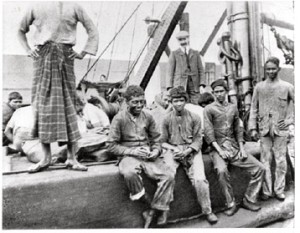[This is a slightly extended version of a piece I wrotein 2010 for the anthology Inside/Out: New Writing from Goa.][i]

I have long been fascinated by nautical dictionaries, especially those that relate to Asian seafarers (or ‘lascars’ as they were once known). Elsewhere I have written at some length about Thomas Roebuck’s magisterial lexicon of the Laskari language (An English And Hindostanee Naval Dictionary), which was first published in Calcutta in 1811: “Born in 1781, Roebuck was a skilled linguist, who had served a rigorous apprenticeship under the famous John Borthwick Gilchrist, author of the first major Hindi-English dictionary. From 1806 to 1809 Roebuck was in Edinburgh assisting Gilchrist to prepare his lexicon. After that, while traveling to Calcutta on the Hon’ble Company Ship Larkins, Roebuck passed his time by compiling his Naval Dictionary … Roebuck did not long survive the publication of his dictionary, dying of a fever in Calcutta at the age of 38. But he did live to see the proof of his work’s usefulness, for in 1813, two years after its first publication, his Dictionary was reprinted by the East India Company’s booksellers in London. In 1882 it was revised and reissued by a missionary called George Small, under the title A Laskari Dictionary Or Anglo-Indian Vocabulary Of Nautical Terms And Phrases In English And Hindustani.[ii] Under that name it continued to circulate well into the 20th century.”[iii]
Roebuck’s was not the only dictionary of this kind to be in circulation in the 19th and early 20th centuries. There were a few others, including one by a Goan (or possibly East Indian) seaman called Antony Vaz.
Vaz was by profession a master sailmaker (‘silmagoor’ in Laskari), employed in the government dockyard in Bombay in the 1870s. But he was also, evidently, a dedicated wordsmith for in 1879 he published a fine compendium called: The Marine Officer’s Hindustani Interpreter Containing A Vocabulary Of Nautical Terms, Directions For Masting, Rigging And Working Ship At Sea, (Bombay Gazette Steam Press, Bombay, 1879).
The preface to this booklet is interesting enough to quote at some length. Vaz writes: ‘Under the favourable auspices of commerce the number of ships visiting the several seaports of India has of late years greatly increased and shipowners, who confine their operations chiefly to this part of the world, have found it profitable to employ Indian crews on their vessels. Against the advantages offered by the employment of these men have to be weighed some petty inconveniences, one of which is felt in conveying orders in the native language with which ships officers are, in a majority of cases, unacquainted. This Book is an humble effort to help those who have not acquired a sufficient knowledge of the vernaculars, in giving the various orders to the seamen, incidental on board a ship…. In getting up the work I have drawn entirely upon my own resources, depending of the knowledge of seamanship acquired by rote during fourteen years service at sea and have therefore to crave the indulgence of the public for any shortcomings they may find therein.
‘Hindustani is the language into which the sentences have been rendered – not literally, but as the natives are accustomed to hear the orders shouted out, in most cases in a contracted form, and the spelling is adopted on the same principle without regard to the Jonesian or any other system. The rendering into the vernacular is not Oordoo or the critical style spoken by the Mahomedans of Delhi or the Deccan Hyderabad, as such translation would be quite out of place on board a ship, from the inability of the men generally to comprehend that style. The technical names of Spars, Yards, the standing and running Rigging, Gears, Sails and words that relate to the manoeuvering and working of ships at sea are all Arabic in their origin.’
[i] My thanks to Cecil Pinto, at whose behest the piece was written.
[ii] Thomas Roebuck: A Laskari Dictionary Or Anglo-Indian Vocabulary Of Nautical Terms And Phrases In English And Hindustani, revised and corrected by George Small, W.H.Allen & Co., London, 1882.

Interesting novel, Bhojpuri language fascinates me since it went thru further changes and today we Fijians have concocted our own Fiji Baat which is different from the languages form UP and Bihar though akin.
You have traced some of the trials and tribulations that the girmityas, I wish you would have wrote a non-fiction, anyways from now I have pledged to read more Indian writers. Since we are the third generation of the Jahaji’s there was nothing disclosed by our Grandparents of the atrocities of the days of the Girmit. Thanks for writing the novel it hits sore spots several times.
The Malim Sahib’s Hindustani by C T Willson of the Bombay Pilot Service – “For ship’s officers who wish to acquire a working knowledge of low Hindustani spoken by native crews, coolies, servants and longshoremen generally. All nautical terms and words in common use both ashore and afloat are included.”
First published by Brown, Son and Ferguson Ltd of Glasgow, in 1920, and reprinted in 2007 – it was an essential basic guide to P&O officers like myself in the 1960s, when all orders to our Lascar crews were given in Hindustani. Fortunately, many of our Serangs and Tindals were able to speak English – and able to translate for us as required!